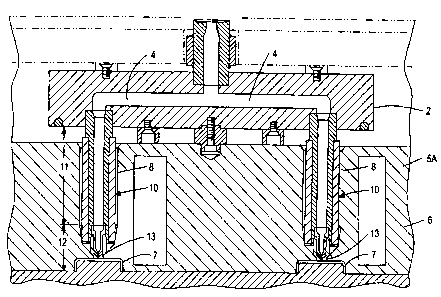Une partie des informations de ce site Web a été fournie par des sources externes. Le gouvernement du Canada n'assume aucune responsabilité concernant la précision, l'actualité ou la fiabilité des informations fournies par les sources externes. Les utilisateurs qui désirent employer cette information devraient consulter directement la source des informations. Le contenu fourni par les sources externes n'est pas assujetti aux exigences sur les langues officielles, la protection des renseignements personnels et l'accessibilité.
L'apparition de différences dans le texte et l'image des Revendications et de l'Abrégé dépend du moment auquel le document est publié. Les textes des Revendications et de l'Abrégé sont affichés :
| (12) Brevet: | (11) CA 2555897 |
|---|---|
| (54) Titre français: | POT DE CHAUFFAGE SERVANT D'ACCESSOIRE A UNE BUSE D'INJECTION POUR SYSTEME DE MOULAGE PAR INJECTION |
| (54) Titre anglais: | HEATING CYLINDER FOR ATTACHMENT TO AN INJECTION NOZZLE FOR AN INJECTION MOLDING SYSTEM |
| Statut: | Accordé et délivré |
| (51) Classification internationale des brevets (CIB): |
|
|---|---|
| (72) Inventeurs : |
|
| (73) Titulaires : |
|
| (71) Demandeurs : |
|
| (74) Agent: | MOFFAT & CO. |
| (74) Co-agent: | |
| (45) Délivré: | 2010-02-02 |
| (22) Date de dépôt: | 2006-08-08 |
| (41) Mise à la disponibilité du public: | 2008-02-08 |
| Requête d'examen: | 2006-08-08 |
| Licence disponible: | S.O. |
| Cédé au domaine public: | S.O. |
| (25) Langue des documents déposés: | Anglais |
| Traité de coopération en matière de brevets (PCT): | Non |
|---|
| (30) Données de priorité de la demande: | S.O. |
|---|
Pot de chauffage creux servant d'accessoire à une buse d'injection pour système de moulage par injection. Une cartouche de chauffage est enroulé en spirale sur l'extérieur du cylindre. La cartouche de chauffage contient deux conducteurs de chaleur pouvant être chauffés électriquement, qui sont électriquement séparés l'un de l'autre et qui sont situés dans différentes zones en direction longitudinale de la cartouche de chauffage. Un conducteur de chaleur est positionné de manière à chauffer la zone d'embouchure de la buse, alors que l'autre conducteur de chaleur est positionné de manière à chauffer la zone de la tige de la buse.
A hollow heating cylinder for attachment to an injection nozzle for an injection molding system. An elongated heating cartridge is spirally wound on the outside of the cylinder. The heating cartridge contains two electrically heatable heat conductors which are electrically separated from one another and are located in different regions in the longitudinal direction of the heating cartridge. One heat conductor is positioned for heating the mouth region of the nozzle and the other heat conductor is positioned for heating the shank region of the nozzle.
Note : Les revendications sont présentées dans la langue officielle dans laquelle elles ont été soumises.
Note : Les descriptions sont présentées dans la langue officielle dans laquelle elles ont été soumises.

2024-08-01 : Dans le cadre de la transition vers les Brevets de nouvelle génération (BNG), la base de données sur les brevets canadiens (BDBC) contient désormais un Historique d'événement plus détaillé, qui reproduit le Journal des événements de notre nouvelle solution interne.
Veuillez noter que les événements débutant par « Inactive : » se réfèrent à des événements qui ne sont plus utilisés dans notre nouvelle solution interne.
Pour une meilleure compréhension de l'état de la demande ou brevet qui figure sur cette page, la rubrique Mise en garde , et les descriptions de Brevet , Historique d'événement , Taxes périodiques et Historique des paiements devraient être consultées.
| Description | Date |
|---|---|
| Paiement d'une taxe pour le maintien en état jugé conforme | 2024-08-02 |
| Requête visant le maintien en état reçue | 2024-08-02 |
| Représentant commun nommé | 2019-10-30 |
| Représentant commun nommé | 2019-10-30 |
| Inactive : Paiement - Taxe insuffisante | 2011-07-27 |
| Inactive : Paiement - Taxe insuffisante | 2011-07-26 |
| Accordé par délivrance | 2010-02-02 |
| Inactive : Page couverture publiée | 2010-02-01 |
| Préoctroi | 2009-11-17 |
| Inactive : Taxe finale reçue | 2009-11-17 |
| Lettre envoyée | 2009-05-27 |
| Un avis d'acceptation est envoyé | 2009-05-27 |
| Inactive : Lettre officielle | 2009-05-27 |
| Un avis d'acceptation est envoyé | 2009-05-27 |
| Inactive : Approuvée aux fins d'acceptation (AFA) | 2009-05-19 |
| Demande publiée (accessible au public) | 2008-02-08 |
| Inactive : Page couverture publiée | 2008-02-07 |
| Inactive : CIB attribuée | 2008-01-17 |
| Inactive : CIB en 1re position | 2008-01-17 |
| Lettre envoyée | 2007-03-13 |
| Inactive : Correspondance - Transfert | 2007-02-08 |
| Inactive : Lettre de courtoisie - Preuve | 2006-09-19 |
| Inactive : Certificat de dépôt - RE (Anglais) | 2006-09-14 |
| Demande reçue - nationale ordinaire | 2006-09-13 |
| Lettre envoyée | 2006-09-13 |
| Toutes les exigences pour l'examen - jugée conforme | 2006-08-08 |
| Exigences pour une requête d'examen - jugée conforme | 2006-08-08 |
Il n'y a pas d'historique d'abandonnement
Le dernier paiement a été reçu le 2009-08-07
Avis : Si le paiement en totalité n'a pas été reçu au plus tard à la date indiquée, une taxe supplémentaire peut être imposée, soit une des taxes suivantes :
Les taxes sur les brevets sont ajustées au 1er janvier de chaque année. Les montants ci-dessus sont les montants actuels s'ils sont reçus au plus tard le 31 décembre de l'année en cours.
Veuillez vous référer à la page web des
taxes sur les brevets
de l'OPIC pour voir tous les montants actuels des taxes.
Les titulaires actuels et antérieures au dossier sont affichés en ordre alphabétique.
| Titulaires actuels au dossier |
|---|
| INCOE CORPORATION |
| Titulaires antérieures au dossier |
|---|
| JUERGEN EMICH |